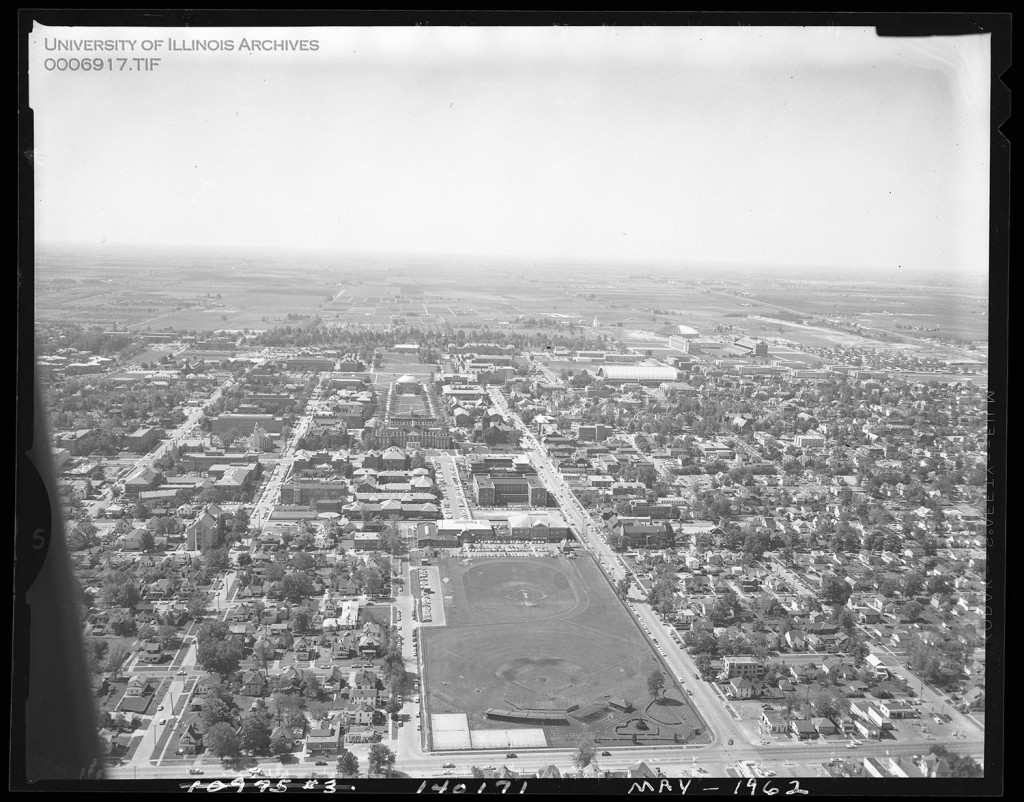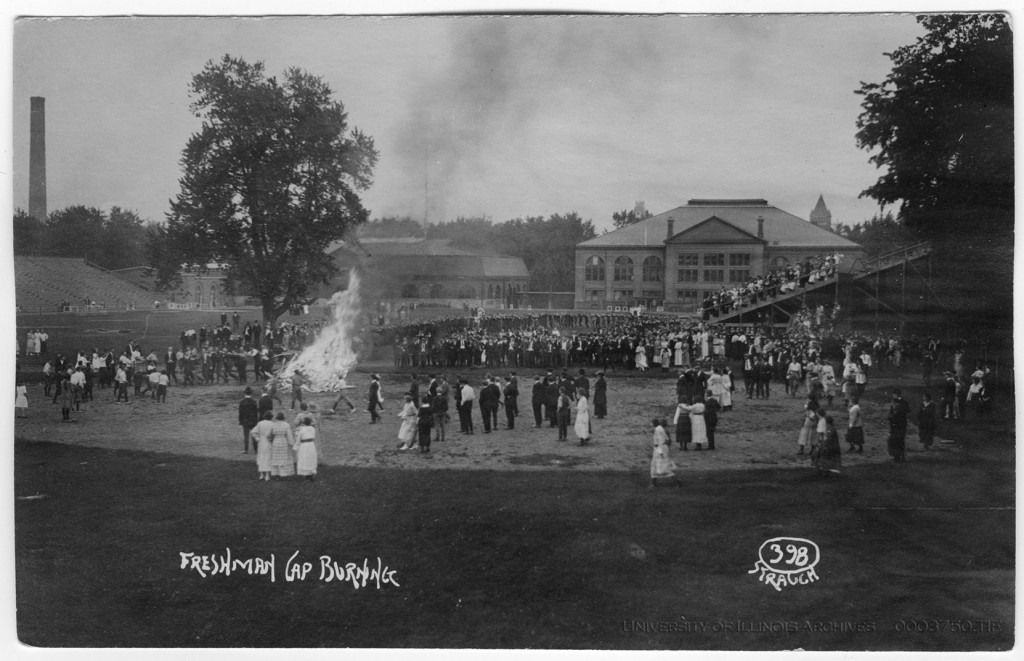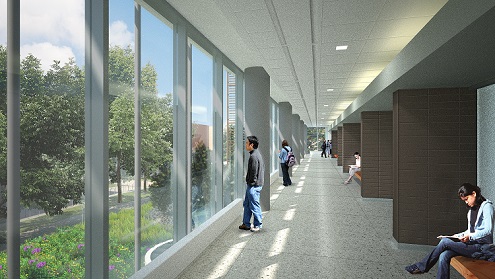Building Campaign Navigation

Investing in the Future
 View our entire construction photo gallery to follow the ECE ILLINOIS Building progress.
View our entire construction photo gallery to follow the ECE ILLINOIS Building progress.
Recent Posts:
- ECE Building includes state-of-the-art music lab
- Donor wall celebrates leadership donors to the Building Campaign for ECE ILLINOIS
- Robotics Laboratory prepares students for the future
- A revamped Digital Signals Lab
- ECE Building grounds’ history with Illinois
- Generating improved power labs
- Low donation funds classroom wing
- Introducing the Open Projects Lab
- $1 million gift makes Srivastava Senior Design Lab possible
THE BUILDING CAMPAIGN FOR ECE ILLINOIS
ECE Building grounds’ history with Illinois
The grounds where the Electrical and Computer Engineering Building now stands have a long history with Illinois.
It’s where the first Illinois students arrived to take classes. Red Grange played his first season at Illinois, helping the football team to an undefeated season. Freshman students burned their signifying caps – which they were required to wear at all times – at the end of each year. The Illini baseball team won 24 Big Ten Conference titles.
These moments of Illinois history took place on the grounds where the ECE Building now stands.
Illinois’ beginnings
The site of the ECE Building has been part of the Illinois campus since the university’s origins. When the university opened as the Illinois Industrial University in 1867, the first university building was located in the north-center of what is now the Beckman quad, between where the Beckman Institute, the Coordinated Science Laboratory, and the ECE Building stand.
This five-story building, variously called the University Building, the Old Main University Building, and “The Elephant,” held classrooms and dormitories for the university’s first students. When a series of destructive storms damaged the building in 1880, it was vacated and torn down, opening up space for Illinois Field.

An aerial shot looking south, with Illinois Field in the foreground, taken 1962. Photo courtesy of the University of Illinois Archives. Click to enlarge.
Illinois Field
The Illini baseball team played on Illinois field for about a century, starting in the 1880s and ending in the 1980s. The team picked up 24 Big Ten Conference titles in that time, and featured famous players like Lou Boudreau, who went on to become a Major League Baseball player and manager who was elected to the Baseball Hall of Fame.
In one particularly famous moment in Illini baseball history in 1903, Jake Stahl hit a home run in an Illinois-Michigan game with the bases loaded, decades before this achievement would become known as a “grand slam.” The ball hit a tree on the way down, which was long after known as the “Jake Stahl home run tree.”
The Illini football team also played on Illinois Field starting in 1891, until the opening of Memorial Stadium in 1923. The team performed exceptionally, earning several undefeated seasons, Big Ten Conference titles, and national championship titles.
In 1910, the Illini were not only undefeated, but also unscored upon for the entire season. That year also marked the first Illinois Homecoming game, which is the second recorded instance in the nation of the now-ubiquitous tradition of football homecoming games.
In the football team’s final year on Illinois Field, the Illini – including first-year player Red Grange – achieved phenomenal success. The team went undefeated that season, winning the Big Ten Conference title and the national championship title. Red Grange went on to become one of the most celebrated of collegiate-level football players and a professional player for the Chicago Bears. Other famous contributors to the Illini throughout the Illinois Field period include Hall-of-Famer George Halas and Robert Zuppke, coach from 1913 to 1941 and College Football Hall-of-Famer.

An image of Illinois Field during the freshman cap burning ceremony, taken from a postcard circa 1913. Courtesy of the University of Illinois Archives. Click to enlarge.
Illinois Field traditions
The centrality of Illinois Field for social life at Illinois went beyond the Illini teams’ success. Students used the field for events and traditions. One of these was the freshman cap burning.
In the early 20th century at Big Ten schools, including Illinois, upperclassmen pressured male freshman students to wear caps that would identify them as freshmen. At Illinois, they were green caps called “spots” that freshmen were expected to purchase and wear constantly during the entire academic year.
At the end of the year, the freshman students would hold a ceremony, burning their caps to mark their elevation to sophomore status. Often, they held this ceremony at Illinois Field, as shown in the above postcard image.
When you visit the ECE Building this fall, whether you are a student arriving for classes or an alumnus returning for our building dedication Oct. 10 or the Alumni Board Homecoming Open House on Oct. 25, we invite you to think on the importance this place has had to Illinois over the decades. The place where ECE ILLINOIS’ faculty will guide some of the nation’s brightest students has an abundant history.
And you will be part of a new chapter in this place’s history – a chapter authored by ECE ILLINOIS students, faculty, and alumni.
Generating improved power labs
For researchers and students interested in power and energy, the photovoltaic array atop the Electrical and Computer Engineering Building is perhaps the department’s most visibly different space from the facilities in Everitt Laboratory. But it isn’t the only one.
ECE ILLINOIS is enhancing the power and energy lab experience. The power area’s instructional lab, the Grainger Electrical Machinery Laboratory, recently received an upgrade, providing undergraduate students with better equipment.
The Advanced Power Applications Laboratory will give graduate researchers direct access to the building’s solar panels, offering them chances for hands-on renewable energy research. And a new lab will join them: the Design Annex, a space where undergraduate students can perform research and work on projects that emphasize power and energy.
Grainger Electrical Machinery Laboratory
The Grainger Electrical Machinery Laboratory is tied to specific senior-level courses, such as ECE 431, Electric Machinery, and ECE 469, Power Electronics Laboratory. Earlier this year, the lab upgraded its benches. The lab has new oscilloscopes, power sources, and meters, and each bench has a coupled motor-generator for motor and generator experiments.
Now, that equipment has a new home in the ECE Building, where there is far more space for it. The size of the laboratory room itself is now larger, it has a dedicated service space for benches, and it is attached to an adjacent classroom. The lecture portion of laboratory courses can occur in the classroom, and the students can then walk directly into the lab.
Assistant Professor Robert Pilawa-Podgurski noted that, with the larger lab space, ECE ILLINOIS can accommodate more students interested in power and energy.
“Both the power electronics course and the laboratory have been over-subscribed the last two years,” Pilawa said. “So it’s exciting that now we can welcome a few more students each year that want to take it.”
Professor George Gross added that the lab is instrumental in helping students understand the applications of the concepts covered in class.
“In terms of teaching purposes, we have some of the best power labs in the world,” he said.
Advanced Power Applications Laboratory
In Everitt Laboratory, the research spaces for power and energy were dispersed across multiple rooms, making it difficult to operate.
“We’re unifying all the labs of the researchers into one integrated lab environment,” Gross said. “It’s going to be much better for interaction among and with the students.”
Taking advantage of the photovoltaic array atop the ECE Building, graduate student researchers in the Advanced Power Applications Laboratory will have direct access to the roof where the solar panels will be placed.
“The goal is to get the students to experiment with solar. A portion of the array will be directly hands-on,” Pilawa said.
Gross added that solar energy is perhaps the fastest-growing segment of renewable energy resources, and hands-on work with solar energy technology on a large scale is an invaluable experience for young researchers.
Design Annex
One of the ECE Building’s all-new lab spaces is the Design Annex. This new lab will offer undergraduate students a space for research and senior design projects that have a primary emphasis on power and energy.
“In the power and energy area, we have quite heavy undergraduate research involvement,” Pilawa said. “In Everitt, we struggled to accommodate this. But now we have a space for our undergraduate students doing design or project research.”
The new lab will provide the equipment that undergraduates need for their research and projects, as well as the support to use that equipment.
“We have a dedicated hardware engineer, Kevin Colravy, who manages a lot of the undergraduate research teams and provides lab support, to find all the right equipment students need to do their work safely,” Pilawa said.
Once the solar panels have been installed in the fall, students in all three of these lab spaces will look out the windows to the roof and the photovoltaic array – an example and symbol of what can be accomplished with state-of-the-art energy technology.
“It’s an exciting time for students who are interested in power and energy,” Pilawa said.
Low donation funds classroom wing
Though neither will be here to see the opening of the ECE Building, Frank and Irene Low were among the first to realize the impact a new facility would have on the department.
In 2001, they designated a $7 million estate gift to ECE with the intent of supporting a new building for the department. In honor of their incredible vision and generosity, the southwest wing of the building’s first floor will be named the Frank D. and Irene M. Low Classroom Wing.
The Frank D. and Irene M. Low Classroom Wing provides a key secondary entrance to the building on the Wright Street side. The wing is home to two 113-seat classrooms. Both classrooms feature a tiered design ideal for lectures, conferences, demonstrations, public seminars, and other events. Outside the classrooms, naturally-lit student seating is built into the hallway. Once the building’s landscaping is complete, the hallway’s grand windows will overlook the building’s native-plant garden. Thousands of students will pass through the wing every year, benefiting from the Lows’ gift to the department.
The Lows wanted their gift to aid construction projects, knowing that large-scale investments like the ECE Building would be a key to the department’s long-term success. Their donation expresses their dedication to ensuring a strong future for engineering students at Illinois. Frank, as a department alumnus, understood how important advanced facilities would be for ECE to maintain its position as a leading source of innovation and instruction in the field.
Frank Low, born November 14, 1912, earned his bachelor’s degree in electrical engineering from Illinois in 1934. He grew up in St. Genevieve, Missouri, and Davenport, Iowa, where he graduated from high school. At Illinois, he was a member of the Beta Psi and the Pi Tau Pi Sigma societies. After graduation, Frank first worked for Sangamo Electric Cooperative in Springfield and then, starting in 1947, he spent the bulk of his career at General Electric as an engineer in the Hotpoint Appliance Division. He held 34 patents, mainly for electrical components of washing machines and dishwashers. He earned a place in GE’s Hall of Fame for his distinguished and successful career. Frank passed away December 26, 2001.
Irene Low, born October 11, 1912, grew up in Evanston, Illinois, attending Evanston High School. She earned her bachelor’s degree at Northwestern University while participating in cheerleading and basketball. After graduating, she earned a master’s degree in psychology at the University of Chicago. Dedicated to education, she spent part of her career as a teacher at the Illinois School for the Deaf and Blind. Irene joined the University of Illinois Presidents Council in 2002 and was a member at the Laureate Circle level. She passed away December 22, 2009.
This story was originally posted on the ECE ILLINOIS website.
Recent Posts
- Introducing the Open Projects Lab
- $1 million gift makes Srivastava Senior Design Lab possible
- Rewiring the ECE 110 lab
- Intel donation to provide undergrads a chance to work in groundbreaking nanofabrication lab
- Fredric G. Nearing Family Classroom will be a reflection of distinguished alum
- Introducing the ECE cafe: “Daily Byte”
- Students present scale model of ECE building at EOH





